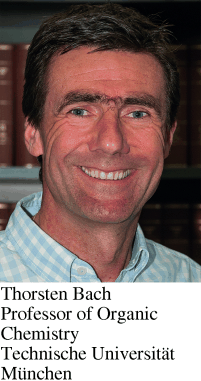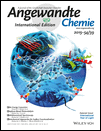More Chemistry with Light! More Light in Chemistry!
Graphical Abstract
“…︁ Why is chemistry overlooked when talking about light? Is the photon a physical particle per se? Are all important light-induced processes biological? Maybe the role of light for chemistry and the role of chemistry for light may be far less important than a few eccentric scientists would like to believe. From the perspective of a synthetically oriented photochemist, however, the facts are different …︁” Read more in the Editorial by Thorsten Bach.
After agreeing to write an Editorial for this special issue of Angewandte Chemie, I had a look at the official UNESCO International Year of Light and Light-Based Technologies website (http://www.light2015.org/Home.html). It surprised me that there was no institution among the named partners and patrons that I would have connected in any way with chemistry. Upon continuing to browse through the site, I kept struggling to find anything that links light with chemistry or chemistry with light. Topics such as photonics, lasers, energy, and photosynthesis are focal points of the presentation, while chemistry seems to receive virtually no attention.1

Why is chemistry overlooked when talking about light? Is the photon a physical particle per se? Are all important light-induced processes biological? Inspection of the list of Nobel Prizes in Chemistry would seem to suggest so, as it appears that discoveries related to light were appreciated only if they enabled the visualization of nature, that is, if they were related to spectroscopic techniques. Hence, chemical reactions (the entire field of photochemistry), have yet to be recognized. Even in the official statement that honors the achievements of Nobel Laureate E. J. Corey (who was one of the first to apply [2+2] photocycloaddition chemistry to complex syntheses) there is no mention of photochemistry.
When reading these lines, one might laconically conclude that the role of light for chemistry and the role of chemistry for light may be far less important than a few eccentric scientists would like to believe. From the perspective of a synthetically oriented photochemist, however, the facts are different, and this situation leads me to the plea that became the title of this Editorial. Let me describe from my personal and very subjective point of view a few key issues featuring the particular importance of the interaction between light and chemistry.
Photochemistry as the Key to Novel Structures
If synthesis is envisaged as architecture on the molecular level, the structure of a molecule is simultaneously the target and the source of chemical inspiration. Accessing the full breadth of structural space is not merely an academic competition, but a vital necessity in the search for novel agents and drugs. In the same way as an architect is restricted to certain structural elements by defined construction techniques, the repertoire of a chemist is limited by the available methods.
In this context, photochemistry has established itself as a science, which makes—unlike any other branch of chemistry—unprecedented structures available. It thus dramatically expands the opportunities for the synthetic chemist and spurs her or his creativity. The intrinsic energy uptake means that the absorption of light by a molecule enables the preparation of strained and complex ring systems, the preparation of which has proven elusive when using conventional thermal processes. The excited state opens reaction pathways that are not (or are barely) accessible from the ground state. Photochemistry is therefore the method of choice if new rigid skeletons bearing spatially defined functional groups are to be constructed.
Energy Efficiency by Absorption of Visible Light
The low cost of energy currently tempts us to downplay the quest for the sustainable and environmentally compatible production of chemicals. It is obvious, however, that solar light will remain the only reliable source of energy for the refinement of raw materials and for the production of fine chemicals in the long run. The application of light-induced processes can avoid the need for any further external energy supply, as the molecule takes up sufficient energy upon photochemical excitation for immediate product formation.
Many processes that are currently only realized at a significant energetic price should become feasible in an energy-efficient fashion with the aid of catalysts that transfer electrons or energy to a given substrate upon light absorption. Organic dyes or colored inorganic complexes allow the use of long-wavelength light as an energy source for a multitude of reactions. Moreover, recent results indicate that if suitable chiral catalysts are employed, even enantioselective photochemical reactions will not remain academic curiosities in the future.
In this context, there is no doubt that artificial photosynthesis is the ultimate goal, with the potential to simultaneously solve several key problems facing mankind. Despite significant progress in recent years, the generation of reducing equivalents upon light absorption, so beautifully mastered by Nature, has not yet found its analogous synthetic realization. The efficient recirculation of carbon dioxide into the lifecycle of carbon compounds requires an imminent energy-efficient solution, which future generations will measure us by. When aiming to realize these goals and when aiming at the synthesis of potential catalysts for model systems of artificial photosynthesis, it will eventually be the chemist whose creativity, knowledge about molecular structures, and methodological competence can offer viable solutions.
No Interdisciplinarity without Methodological Competence
For too long, the term interdisciplinarity has served as a buzzword to play down the chemist’s role in a comprehensive scientific context. Of course, many exciting innovations and discoveries are made at the interface where chemistry meets the other sciences. This fact is undisputed and photochemistry offers many prototypical examples. Molecular switches, biological imaging, organic light-emitting diodes, photodynamic therapy, functional dyes, photovoltaics: the keyword list for important interdisciplinary topics in photochemistry is long and keeps growing. Against this background the chemist must, however, not be reduced to a mere supplier of compounds. The unfortunate, still widely distributed idea that any molecule with any given structure can be simply and readily prepared does not become any truer because self-declared experts continue to repeat it. There are numerous examples of target molecules related to a specific application that could not be made in a given timeframe, because the required method did not exist. This statement is particularly applicable to branches of chemistry that have—in the spirit of what has just been said—the stigma of being fully explored, for example, heterocyclic chemistry.
A consequence of the necessity for methodological competence, particularly in the field of synthesis, is a better penetration of neighboring disciplines by chemists. One can easily envisage chemistry as a major driver in establishing new connections between crucial topics of synthetic relevance and key topics from other areas of the sciences. It is my firm belief that research on the most challenging subjects in any scientific field, as enumerated for photochemistry, will be of the highest quality if the methodological competence of the chemists is transferred into other areas. A plea to the next generation of researchers in our science is therefore to link their own work as chemists with a relevant aspect in scientifically related fields.
Light and Chemistry in the Public Perception
The observant reader will certainly have realized that the title of this Editorial makes reference to the great natural scientist Johann Wolfgang von Goethe, who was intensively concerned with light, for example in his theory of colors. Therefore, it is not surprising that legend would have us believe that his deathbed cry was: “More light!”. There are doubts, however, whether this claim is historically sound. In the spirit of the plea made in the previous section a much more widely documented Goethe quote could be invoked, which derives from one of his later pieces, Wilhelm Meisters Wanderjahre. It says: “Knowing is not enough, we must apply. Willing is not enough, we must do.”
In summary, as discussed solely from the perspective of organic photochemistry, the current International Year of Light serves as a good reason to intensify research that deals with any kind of interaction between light and chemistry. In this personal reflection, I was bound to neglect many topics and arguments that apply to other branches of chemistry—one only needs to consider the importance of light to the wide range of analytical and spectroscopic techniques that I have only briefly mentioned.
Of course, the introduction to this Editorial was meant to be provocative. There are very well-produced websites related to the International Year of Light, several of which put chemistry at center stage. For example, the Gesellschaft Deutscher Chemiker (GDCh; German Chemical Society) has a project coordinated by A. G. Griesbeck and R. Hoer collecting excellent contributions that cover all facets of the interaction between chemistry and light. This site can be found in a section called Aktuelle Wochenschau (http://www.aktuelle-wochenschau.de/main-navi/startseite.html). There thus remains hope that at least the interested general public gets a more detailed picture of what chemistry currently offers in the context of the International Year of Light and what it can bring to society in the future.





